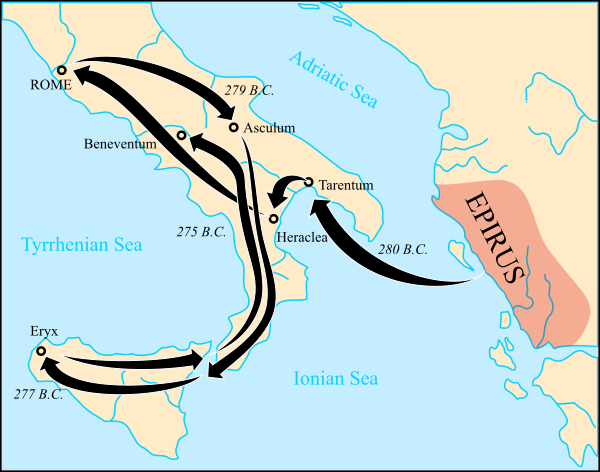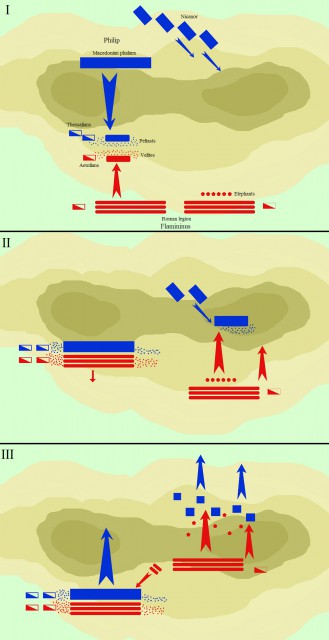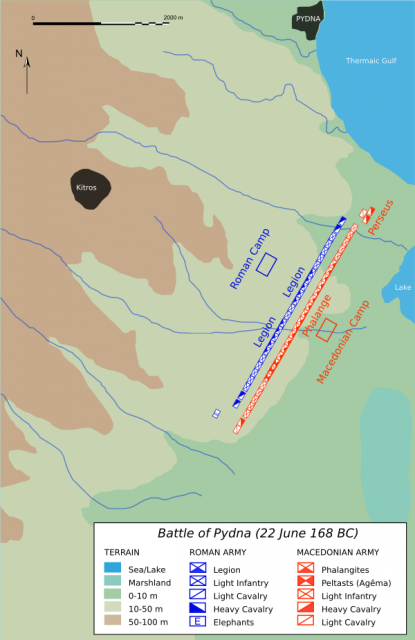|
|
While Alexander’s empire grew and fragmented, The Romans were busy with their arduous task of conquering Italy. Initially adopting a hoplite style phalanx due to influence from southern Italian Greek colonies, the army eventually transformed into the flexible manipular legion. This transformation was likely a result of the Samnite wars fought in the varied mountainous terrain of central Italy where the Romans needed a more adaptable formation. The Roman manipular legion and the Macedonian phalanx were each pivotal factors in the successes of their states, but was one formation actually better than the other?
The best descriptions of the formations come from the historian Polybius. Raised in Greece, Polybius fought in Greek battles before being sent to Rome as a hostage, though given great freedoms during his stay. In Rome Polybius studied Roman warfare and so had experience with both phalanx and maniple style warfare.
The two formations actually met in battle a handful of times with varied results. The first combats were during Pyrrhus’ invasion of Italy in 280 BCE. Three major battles were fought with the first two being Pyrrhic victories for Pyrrhus. At Heraclea and Asculum the tried and true Macedonian phalanx faced the Roman maniple that had only been established 40-100 years before.
 Pyrrhus
won these battles but the maniples but forth a valiant effort and
caused heavy casualties. At the battle of Beneventum a few years later
the Romans finally prevailed, with help from Pyrrhus’ elephants which
charged back into his own lines. Details for these battles are scarce
but it seems that though the phalanx did indeed steamroll through the
Romans, it was done with great difficulty and at Beneventum the
flexibility of the maniples allowed them to seize the openings caused by
the rampaging elephants to cause a rout.
Pyrrhus
won these battles but the maniples but forth a valiant effort and
caused heavy casualties. At the battle of Beneventum a few years later
the Romans finally prevailed, with help from Pyrrhus’ elephants which
charged back into his own lines. Details for these battles are scarce
but it seems that though the phalanx did indeed steamroll through the
Romans, it was done with great difficulty and at Beneventum the
flexibility of the maniples allowed them to seize the openings caused by
the rampaging elephants to cause a rout.After Pyrrhus’ invasion the Romans fought titanic wars against Carthage that brought them to superpower status in the Mediterranean. Barely after wrapping up the second Punic war, the Romans invaded Macedon to take the fight to Philip V, who had been an ally of Carthage and was now harassing Roman-allied Greek cities. The armies of Rome and Philip’s phalanx army met at Cynoscephalae, with a large hill separating the two camps.

Meanwhile the remaining Roman right wing advanced up the hill and met the rest of Philips army as they were arriving in bunches. The flexibility of the maniples allowed them to surround and destroy each unit until the rest of Philip’s forces fled. This battle shows the ingenuity and freedoms allowed to Roman officers to enable them to make a battlefield decision that profoundly influenced the outcome.
The last great example of maniple and phalanx battle is found at the battle of Pydna during the third Macedonian war between Rome and Perseus. The decisive battle happened on flat ground not too far from the site of Thermopylae. The Macedonians outnumbered the Romans about 44,000 to 29,000 but both forces were equal in cavalry.
The two armies lined up each splitting the cavalry on the wings and the Macedonian phalanx advanced. The Roman infantry met the phalanx and did not break, but were steadily forced back towards the broken ground behind them. As the long phalanx line pushed forward they began to break formation as some areas pushed forward more than others and the uneven ground began to break the formation.

This last battle shows the small unit tactics for which the maniple was built towards but also shows how well the maniple fit the Romans as a people. Romans were fiercely brave and it took quite a feat of bravery to be among the first to jump into an enemy formation bristling with spears to open up gaps for your fellow soldiers.
The battles certainly showcase the maipular legion’s flexibility over the powerful but stiff Macedonian phalanx, but it would have been impossible with all the different variables to find a perfect battlefield matchup of the two formations. Each of the battles mention featured varying skill and experiences for the commanders and the armies in general. The Macedonian phalanx continued to be used from Germany to Egypt and did prove to be effective. Even a minimally equipped and trained phalanx was still a forward moving force to be reckoned with, and the Roman style of warfare found little success outside of Rome. The pliability of the maniple allowed them to fight in any size group from whole legion advances to the individual soldier, ready for any occasion on the battlefield with two javelins, a large shield and an effective gladius.
By William McLaughlin for War History Online




Δεν υπάρχουν σχόλια:
Δημοσίευση σχολίου